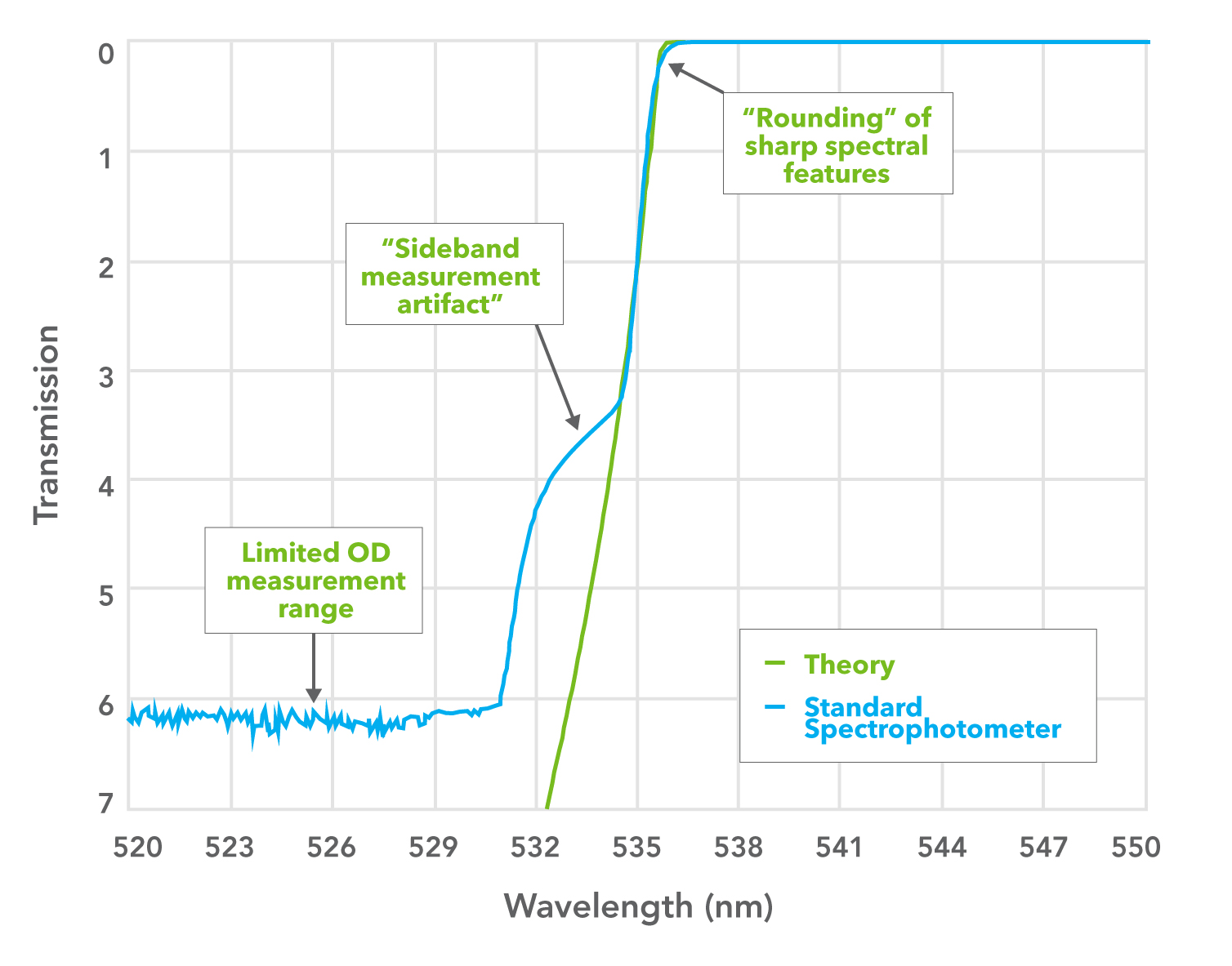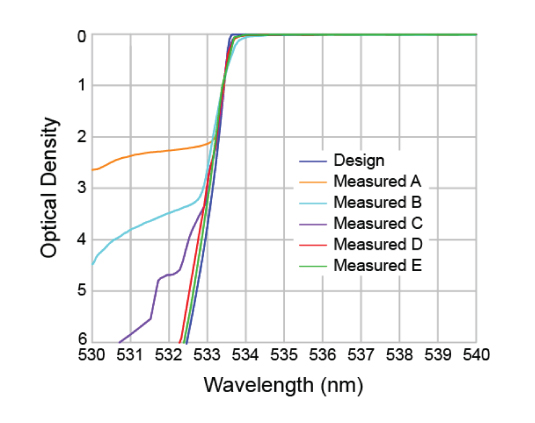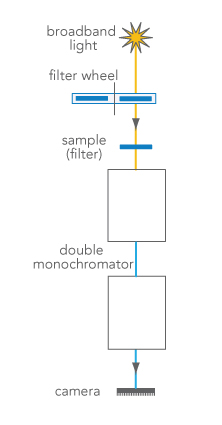Measurement of Optical Filter Spectra

 Due to limitations of standard metrology techniques, the measured spectral characteristics of thin-film interference filters are
frequently not determined accurately, especially when there are steep and deep edges. The actual blocking provided by an optical filter is determined not only by its designed spectrum, but also by physical imperfections of the filter, such as pinholes
generated during the thin-film coating process, dirt and other surface defects, or flaws in the filter mounting. Generally commercially available spectrophotometers are used to measure the transmission and OD spectral performance of optical filters.
However, these instruments can have significant limitations when the optical filters have high edge steepness and / or very deep blocking.
Due to limitations of standard metrology techniques, the measured spectral characteristics of thin-film interference filters are
frequently not determined accurately, especially when there are steep and deep edges. The actual blocking provided by an optical filter is determined not only by its designed spectrum, but also by physical imperfections of the filter, such as pinholes
generated during the thin-film coating process, dirt and other surface defects, or flaws in the filter mounting. Generally commercially available spectrophotometers are used to measure the transmission and OD spectral performance of optical filters.
However, these instruments can have significant limitations when the optical filters have high edge steepness and / or very deep blocking.
As a result of these limitations, three main discrepancies appear between an actual filter spectrum and its measured representation (see Fig. 1 left). The first discrepancy is the “rounding” of sharp spectral features. This effect results from the non-zero bandwidth of the spectrophotometer probe beam. The second measurement discrepancy arises from limited sensitivity of the spectrophotometer. The third discrepancy is unique to measurements of very steep transitions from high blocking to high transmission, and is referred to as a “sideband measurement artifact.” This artifact arises from the non-monochromatic probe beam that also has weak sidebands at wavelengths outside of its bandwidth.
 Semrock utilizes different measurement approaches to evaluate filter spectra. As an example, Figure 2 (on right) shows five measured
spectra of the steep edge of an E-grade RazorEdge® filter that is guaranteed to block a laser line at 532 nm with OD > 6 and transition to high transmission within 0.5% of the laser wavelength (by 534.7 nm). The measured spectra
are overlaid on the design spectrum of the filter (blue line). As observed in this figure, choice of a particular measurement instrument and technique greatly influences the measured spectrum of a filter. Measurement method “A” in this
graph is from a custom-built spectrophotometer. This measurement uses instrument settings – such as short detector integration time and low resolution – that are optimized for very rapid data collection from a large number of sample filters
during thin-film filter manufacturing process. However this method has poor sensitivity and resolution. Measurement method “B” uses a standard commercial spectrophotometer (PerkinElmer LAMBDA 900 series).
Semrock utilizes different measurement approaches to evaluate filter spectra. As an example, Figure 2 (on right) shows five measured
spectra of the steep edge of an E-grade RazorEdge® filter that is guaranteed to block a laser line at 532 nm with OD > 6 and transition to high transmission within 0.5% of the laser wavelength (by 534.7 nm). The measured spectra
are overlaid on the design spectrum of the filter (blue line). As observed in this figure, choice of a particular measurement instrument and technique greatly influences the measured spectrum of a filter. Measurement method “A” in this
graph is from a custom-built spectrophotometer. This measurement uses instrument settings – such as short detector integration time and low resolution – that are optimized for very rapid data collection from a large number of sample filters
during thin-film filter manufacturing process. However this method has poor sensitivity and resolution. Measurement method “B” uses a standard commercial spectrophotometer (PerkinElmer LAMBDA 900 series).
 All of the discrepancies between the actual filter spectrum and the measured spectrum as noted above are apparent in this measurement. Measurement
methods “C” and “D” utilize the same custom-built spectrophotometer from method “A.” The basic principle of operation of this spectrophotometer is shown in Fig. 3 (left). This instrument uses a low-noise CMOS camera
(i.e., detector array) capable of measuring a wide range of wavelengths simultaneously. Measurement method “C” uses instrument settings (primarily integration time and resolution) designed to provide enhanced measurement of the steep and
deep edge. However, the “sideband measurement artifact” is still apparent. Measurement method “D” is a modification of method “C” that applies additional filtering to remove this artifact. Method “E”
shows the results of a very precise measurement made with a carefully filtered 532 nm laser and angle tuning of the filter itself. Experimentally acquired transmission vs. angle data is converted into transmission vs. wavelength results, using a theoretical
model. Clearly, this measurement method comes closest to the actual design curve; however it is not as suitable for quality assurance of large volumes of filters.
All of the discrepancies between the actual filter spectrum and the measured spectrum as noted above are apparent in this measurement. Measurement
methods “C” and “D” utilize the same custom-built spectrophotometer from method “A.” The basic principle of operation of this spectrophotometer is shown in Fig. 3 (left). This instrument uses a low-noise CMOS camera
(i.e., detector array) capable of measuring a wide range of wavelengths simultaneously. Measurement method “C” uses instrument settings (primarily integration time and resolution) designed to provide enhanced measurement of the steep and
deep edge. However, the “sideband measurement artifact” is still apparent. Measurement method “D” is a modification of method “C” that applies additional filtering to remove this artifact. Method “E”
shows the results of a very precise measurement made with a carefully filtered 532 nm laser and angle tuning of the filter itself. Experimentally acquired transmission vs. angle data is converted into transmission vs. wavelength results, using a theoretical
model. Clearly, this measurement method comes closest to the actual design curve; however it is not as suitable for quality assurance of large volumes of filters.
In summary, it is important to understand the measurement techniques used
to generate optical filter spectra, as these techniques are not perfect. Use of the appropriate measurement approach for a given filter or application can reduce errors as well as over-design of experiments and systems that use filters, thus optimizing
performance, results, and even filter cost.
For additional information on this topic read our white paper: Advanced Spectral Measurement Systems and Semrock Optical Filters
